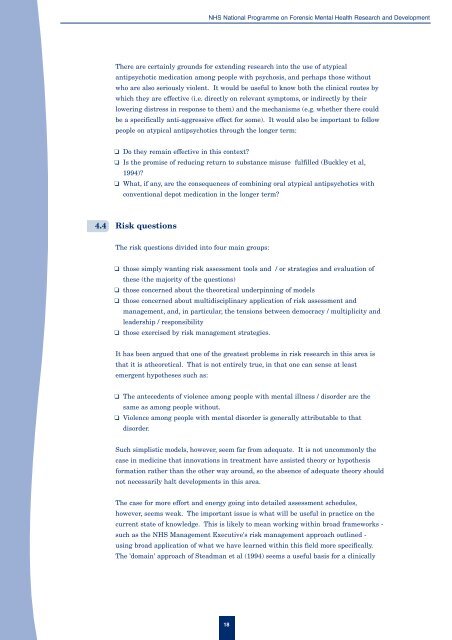Mental Illness and Serious Harm to Others - University of Liverpool
Mental Illness and Serious Harm to Others - University of Liverpool
Mental Illness and Serious Harm to Others - University of Liverpool
Create successful ePaper yourself
Turn your PDF publications into a flip-book with our unique Google optimized e-Paper software.
NHS National Programme on Forensic <strong>Mental</strong> Health Research <strong>and</strong> Development<br />
There are certainly grounds for extending research in<strong>to</strong> the use <strong>of</strong> atypical<br />
antipsychotic medication among people with psychosis, <strong>and</strong> perhaps those without<br />
who are also seriously violent. It would be useful <strong>to</strong> know both the clinical routes by<br />
which they are effective (i.e. directly on relevant symp<strong>to</strong>ms, or indirectly by their<br />
lowering distress in response <strong>to</strong> them) <strong>and</strong> the mechanisms (e.g. whether there could<br />
be a specifically anti-aggressive effect for some). It would also be important <strong>to</strong> follow<br />
people on atypical antipsychotics through the longer term:<br />
❑ Do they remain effective in this context?<br />
❑ Is the promise <strong>of</strong> reducing return <strong>to</strong> substance misuse fulfilled (Buckley et al,<br />
1994)?<br />
❑ What, if any, are the consequences <strong>of</strong> combining oral atypical antipsychotics with<br />
conventional depot medication in the longer term?<br />
4.4 Risk questions<br />
The risk questions divided in<strong>to</strong> four main groups:<br />
❑ those simply wanting risk assessment <strong>to</strong>ols <strong>and</strong> / or strategies <strong>and</strong> evaluation <strong>of</strong><br />
these (the majority <strong>of</strong> the questions)<br />
❑ those concerned about the theoretical underpinning <strong>of</strong> models<br />
❑ those concerned about multidisciplinary application <strong>of</strong> risk assessment <strong>and</strong><br />
management, <strong>and</strong>, in particular, the tensions between democracy / multiplicity <strong>and</strong><br />
leadership / responsibility<br />
❑ those exercised by risk management strategies.<br />
It has been argued that one <strong>of</strong> the greatest problems in risk research in this area is<br />
that it is atheoretical. That is not entirely true, in that one can sense at least<br />
emergent hypotheses such as:<br />
❑ The antecedents <strong>of</strong> violence among people with mental illness / disorder are the<br />
same as among people without.<br />
❑ Violence among people with mental disorder is generally attributable <strong>to</strong> that<br />
disorder.<br />
Such simplistic models, however, seem far from adequate. It is not uncommonly the<br />
case in medicine that innovations in treatment have assisted theory or hypothesis<br />
formation rather than the other way around, so the absence <strong>of</strong> adequate theory should<br />
not necessarily halt developments in this area.<br />
The case for more effort <strong>and</strong> energy going in<strong>to</strong> detailed assessment schedules,<br />
however, seems weak. The important issue is what will be useful in practice on the<br />
current state <strong>of</strong> knowledge. This is likely <strong>to</strong> mean working within broad frameworks -<br />
such as the NHS Management Executive's risk management approach outlined -<br />
using broad application <strong>of</strong> what we have learned within this field more specifically.<br />
The 'domain' approach <strong>of</strong> Steadman et al (1994) seems a useful basis for a clinically<br />
18
















